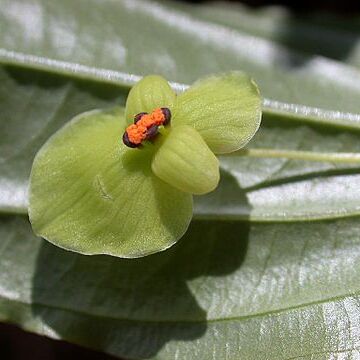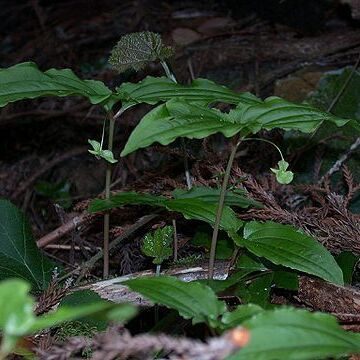Subshrubs, vines, or herbs perennial, with tuberous roots or creeping rhizomes. Stems erect or climbing. Leaves whorled, opposite, or alternate, petiolate or sessile; main veins 3 or more, transverse veinlets numerous. Inflorescences racemes or cymes, 1-to few flowered; peduncle axillary or attached to petiole or leaf midvein. Flowers bisexual, actinomorphic. Perianth segments 4, in 2 whorls, petaloid, free. Stamens 4, subhypogynous; filaments free or basally connate in a ring, very short; anthers dorsifixed or basifixed, erect, linear, introrse; connective usually appendaged, appendage extending beyond apex of anther locule, perianthlike, linear-lanceolate, long. Ovary superior or subinferior, 1-loculed; ovules 2 or more, basally or apically attached to placenta. Stigma sessile, small. Capsule slightly compressed, 2-valved. Seed appendages on or near funicle, arillate; testa leathery; embryo hard, albuminous.
Herbs [herbaceous vines, or low shrubs], caulescent [stemless], from rhizomes [tuberous roots]. Leaves simple, stipules absent. Basal leaves sheathing. Cauline leaves present [absent], alternate [whorled], petiolate, venation ± palmate [arcuate-pinnate with strongly developed midvein], transverse parallel veinlets connecting primary veins. Inflorescences axillary, cymose [racemose or unifloral]. Flowers bisexual, radially [bilaterally] symmetric; perianth hypogynous [to epigynous]; tepals 4[–5], distinct [connate]; stamens 4[–5], opposite tepals; ovary 1-locular; placentation apical [basal]; style 1 [absent]; stigmas [1]–3. Fruits capsular, 2[–3]-valved. Seeds globose [to ellipsoid].


